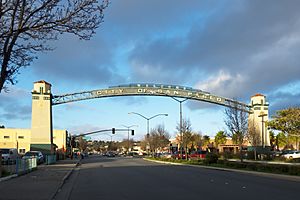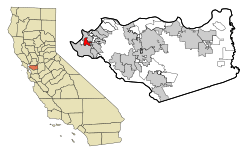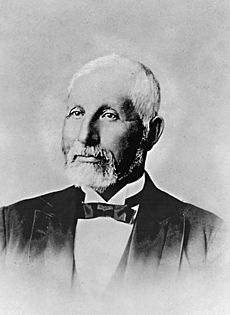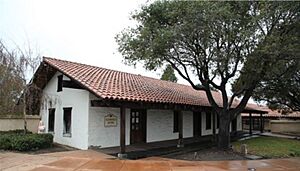San Pablo, California facts for kids
Quick facts for kids
San Pablo, California
|
||
|---|---|---|

Welcome sign over San Pablo Avenue
|
||
|
||
| Motto(s):
"City of New Directions"
|
||

Location in Contra Costa County and the state of California
|
||
| Country | ||
| State | ||
| County | Contra Costa | |
| Incorporated | April 27, 1948 | |
| Area | ||
| • Total | 2.62 sq mi (6.80 km2) | |
| • Land | 2.62 sq mi (6.80 km2) | |
| • Water | 0.00 sq mi (0.00 km2) 0% | |
| Elevation | 52 ft (16 m) | |
| Population
(2010)
|
||
| • Total | 29,139 | |
| • Estimate
(2019)
|
30,990 | |
| • Density | 11,810.21/sq mi (4,559.24/km2) | |
| Time zone | UTC-8 (PST) | |
| • Summer (DST) | UTC-7 (PDT) | |
| ZIP code |
94806
|
|
| Area code(s) | 510, 341 | |
| FIPS code | 06-68294 | |
| GNIS feature IDs | 1659586, 2411801 | |
| Website | sanpabloca.gov | |
San Pablo is a city in Contra Costa County, California, United States. Its name means "Saint Paul" in Spanish. It's like a city surrounded by other towns. In 2020, about 32,127 people lived there.
The city is led by a Mayor and a City Council. The Mayor helps run the city and leads council meetings. The City Council members make important decisions for the community. The current mayor is Patricia Ponce. The city council members are Abel Pineda, Arturo Cruz, Elizabeth Pabon-Alvarado, and Rita Xavier.
Contents
History of San Pablo

The land where San Pablo now stands was once home to the Cuchiyun band of the Ohlone people. They were a group of Native Americans. In the late 1700s, the king of Spain claimed this land. It was used for grazing animals by Mission Dolores, a church property in what is now San Francisco.
When Mexico became independent from Spain in 1821, these church lands became separate from the Catholic church. In 1823, a Mexican governor named Luís Antonio Argüello gave this Ohlone land to Francisco María Castro. He was a former soldier. This large piece of land was called Rancho San Pablo. This is where the city gets its name!
One of the oldest main roads in the East Bay area is also named after the city: San Pablo Avenue. Long ago, during the Spanish time, it was called El Camino Real de la Contra Costa. This means "The Royal Way of the Opposite Coast." It referred to the coast across from San Francisco. San Pablo Avenue starts in San Pablo and goes through the whole East Bay.
San Pablo has a special building called the Alvarado Adobe. It's a California State Landmark (No.512). This building is a copy of a historic home from the city's Mexican past. The original home was built in 1842 by Jesús Maria Castro for his mother, Gabriéla Berryessa de Castro. Jesús was one of Francisco Castro's sons.
After Gabriéla passed away in 1851, her daughter, Martina Castro de Alvarado, received the home. Martina was married to Juan Bautista Alvarado, who was the Governor of California from 1836 to 1842. The first Alvarado Adobe was torn down in the mid-1900s to build a motel. Later, a new version was built. It is now in the San Pablo Civic Center. A single wooden beam from the original building is part of the roof of the new one.
The first post office in San Pablo opened in 1854. The city officially became a city in 1948. Since the mid-1900s, a place called College Center at El Portal has been very important for the community's shopping and businesses.
Where San Pablo Is Located
San Pablo covers about 2.6 square miles (6.8 square kilometers) of land. It sits on a flat area of land between the northern part of the Berkeley Hills and San Pablo Bay. However, the city itself doesn't reach the bay.
Two main creeks, or small rivers, flow through the city: Wildcat Creek and San Pablo Creek. Both of these creeks start in the mountains to the southeast of the city. A smaller creek called Rheem Creek also runs through San Pablo.
The northeastern edge of San Pablo is also crossed by the Hayward Fault. This is a major crack in the Earth's crust, similar to the larger San Andreas Fault which is located to the west.
Interstate 80, a major highway, goes through San Pablo. There are also some communities north of San Pablo that use San Pablo mailing addresses, even though they are separate. These include Tara Hills, Bayview, and Montalvin.
City Economy and Jobs
Top Employers in San Pablo
Here are the biggest employers in San Pablo, based on a report from 2021-2022:
| # | Employer | # of Employees |
|---|---|---|
| 1 | Contra Costa College | 690 |
| 2 | West Contra Costa Unified School District | 434 |
| 3 | Casino San Pablo | 396 |
| 4 | Vale Healthcare Center | 275 |
| 5 | City of San Pablo | 190 |
| 6 | West County Health Center | 165 |
| 7 | Creekside Health Care Center | 138 |
| 8 | San Pablo Healthcare and Wellness Center | 119 |
| 9 | Las Montana's Supermarket | 90 |
| 10 | Food Maxx | 85 |
The Casino San Pablo is a very important part of the city's economy. It helps bring in a lot of money for the city.
Population Information
| Historical population | |||
|---|---|---|---|
| Census | Pop. | %± | |
| 1870 | 1,075 | — | |
| 1890 | 367 | — | |
| 1950 | 14,476 | — | |
| 1960 | 19,687 | 36.0% | |
| 1970 | 21,461 | 9.0% | |
| 1980 | 19,750 | −8.0% | |
| 1990 | 25,158 | 27.4% | |
| 2000 | 30,215 | 20.1% | |
| 2010 | 29,139 | −3.6% | |
| 2020 | 32,127 | 10.3% | |
| U.S. Decennial Census | |||
San Pablo in 2010
In 2010, San Pablo had 29,139 people. This means there were about 11,063 people living in each square mile.
Most people (98.5%) lived in homes. A small number (1.3%) lived in places like nursing homes. There were 8,761 homes in total. About 47% of these homes had children under 18. The average home had about 3.28 people.
About 28% of the people were under 18 years old. About 8.8% were 65 or older. The average age in San Pablo was 31.6 years.
San Pablo in 2000
In 2000, San Pablo had 30,215 people living in 9,051 homes. The average home had about 3.29 people.
About 31.7% of the people were under 18 years old. About 8.7% were 65 or older. The average age was 30 years.
Many different languages are spoken in San Pablo. In 2000, about 42.5% of people spoke English, and about 40.3% spoke Spanish. Other languages included Tagalog, Vietnamese, Miao-Mien, Laotian, Punjabi, and Chinese.
Getting Around San Pablo
San Pablo has a public bus system called AC Transit. These buses can take you to places like the Hilltop Mall Shopping Center, the Richmond Parkway Transit Center, and the Richmond BART and Amtrak station in Richmond. You can also get to the El Cerrito del Norte BART station in El Cerrito. There are also bus services within San Pablo and to El Sobrante.
You can even take a bus directly from San Pablo to the San Francisco Transbay Terminal in San Francisco. There are also late-night buses to Richmond, Pinole, and El Cerrito. AC Transit also provides special bus services for students going to high and middle schools in the West Contra Costa Unified School District.
Another bus service, WestCat, connects Contra Costa College with the Hercules Transit Center. This route runs along San Pablo Avenue, which is a major road going north and south. San Pablo Avenue also has a special fast bus line, the 72R, which connects the college to Downtown Oakland and BART train stations. The college is a big hub for buses in the city. Interstate 80, a major highway, runs along the eastern side of the city.
Schools and Learning
San Pablo is home to a campus of the Contra Costa Community College District. This school is called Contra Costa College. It is part of California's community college system, where students can take classes after high school.
The city also has many schools for younger students, including:
- Tara Hills Elementary School
- Downer Elementary School
- Highland Elementary School
- Dover Elementary School
- Middle College High School
The San Pablo Library is part of the Contra Costa County Library system. It is located at the corner of Church Street and San Pablo Avenue. It moved to this new spot in 2017.
Famous People from San Pablo
- Gene Clines: A former professional baseball player who played in Major League Baseball. He was born in San Pablo.
- Gary Holt: A guitarist for popular metal bands like Slayer and Exodus.
- Eric the Actor: A former caller and actor for the Howard Stern radio show. He was born in San Pablo.
Sister Cities
San Pablo has a "sister city" relationship with:
 Manzanillo, Mexico
Manzanillo, Mexico
See also
 In Spanish: San Pablo (California) para niños
In Spanish: San Pablo (California) para niños




